

Inside Story: The end of China one-child policy: too little too late? China's Lost Girls (Documentary, you need to watch as from the USA though) How China’s One-Child Policy Backfired Disastrously. China's one-child policy was aimed at slashing the nation's population to boost economic growth.
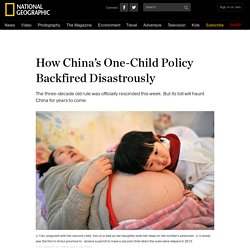
It resulted in millions of forced sterilizations, abortions, infanticide, and marital misery. After more than 30 years, the Central Committee of China’s Communist Party announced Thursday that it would end the rule, easily the country's most unpopular. Mei Fong, a former Pulitzer Prize-winning Wall Street Journal reporter, is author of the forthcoming book One Child: The Past And Future Of China’s Most Radical Experiment.
Speaking from California, she describes how the policy caused an enormous demographic headache for China; why it will take decades to reverse; and how, as a result, China is full of lonely men. Why has China made this decision now? The reason China is doing this right now is because they have too many men, too many old people, and too few young people. China has lifted 600 million people out of poverty. Journalists love that phrase. See How the One-Child Policy Changed China. China's decision to lift its one-child policy next year is expected to diversify the country’s aging, increasingly male population.
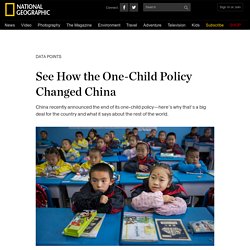
But the degree to which the policy has affected the country of more than 1.3 billion people is hard to imagine. Here are five charts and maps that help illustrate it. Painful legacy of China's one child policy - BBC News. China's one-child policy explained - BBC News. The Daily Show with Trevor Noah - China Ditches Its One-Child Policy. GEOFILE sample. Todaysresearchaging20. Geofile Contrasting Contemporary Case Studies.
GCSE Bitesize: Case study: China. The one-child policy changed China for ever with its cruelty. Chinese married couples are now graciously permitted by the Communist party to have two children.
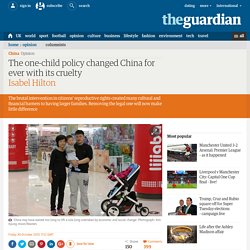
It is a policy adjustment born out of anxiety about the impact on the economy of skewed demographics, and the fear that a shrinking labour force and growing ranks of retirees will condemn China to grow old before it grows rich. But after 35 years of forced abortions, female infanticide, unregistered births and traumatised individuals, the party may find that it was easier to reduce China’s families than to enlarge them.
It will take rather more, at this point, than official permission to change China’s birthrate significantly. In 1969, after 20 years of Maoist disorder, China was an impoverished agrarian society with a typical birthrate of six children per woman. Children were assets then, because they brought an extra pair of hands and a hedge against starvation in old age. By 1979, Mao was dead and Deng Xiaoping took a different view. China's one-child policy – timeline. 1953 Chinese leaders suggest that the population should be controlled and approve a law on contraception and abortion, but the plan is later stranded by political upheaval and the 1959-61 famine. 1970 China's population exceeds 800 million. 1975 China adopts the slogan "late, long and few", encouraging couples to have one child, and urging them to have no more than two. 1979 The Communist party says couples should have no more than one child.
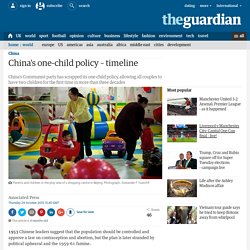
A new marriage law says couples are obliged to practise family planning, placing a de facto limit of one child for each family. 1984 China adjusts the policy, allowing a second child for some families in rural areas and for couples who were both an only child, and in some other specified circumstances. 2001 New laws decreed to better manage the administration of the policy, including penalties for unapproved births. 2013 China adds an exemption allowing two children for families in which one parent, rather than both, is an only child.
China’s 'loneliest generation': what it was like growing up under the one-child policy. “If I’d shared my parents’ resources with brothers or sisters, I wouldn’t be where I am today,” said Jessica, a 23-year-old University of Michigan student, born in Weihai – about 6,500 miles from her current home.
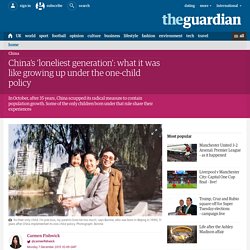
“I have so many options of how I can live my life now, I wouldn’t change a thing,” she said. In 1979, in the grip of a population crisis, China took extreme measures to halt its rapidly expanding society. It began limiting births to one child per couple and administered severe, sometimes barbaric, penalties for deviation from the rule. In October, after 35 years, the policy was scrapped. Many people who have grown up as an only child recall loneliness, isolation and, occasionally, imaginary friends. China ends one-child policy after 35 years. China has scrapped its one-child policy, allowing all couples to have two children for the first time since draconian family planning rules were introduced more than three decades ago.
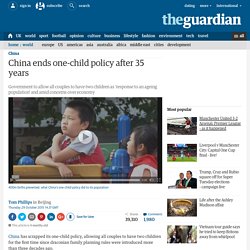
The announcement followed a four-day Communist party summit in Beijing where China’s top leaders debated financial reforms and how to maintain growth at a time of heightened concerns about the economy. China will “fully implement a policy of allowing each couple to have two children as an active response to an ageing population”, the party said in a statement published by Xinhua, the official news agency. “The change of policy is intended to balance population development and address the challenge of an ageing population,” Some celebrated the move as a positive step towards greater personal freedom in China.
But human rights activists and critics said the loosening – which means the Communist party continues to control the size of Chinese families – did not go far enough. Additional reporting by Luna Lin. China one child policy. China’s one child policy Why was it introduced?
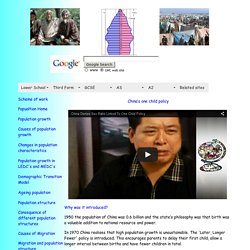
1950 the population of China was 0.6 billion and the state’s philosophy was that birth was a valuable addition to national resource and power. In 1970 China realises that high population growth is unsustainable. The 'Later, Longer Fewer' policy is introduced. This encourages parents to delay their first child, allow a longer interval between births and have fewer children in total. By 1975 the BR was at 33/1000; the population was at 0.9 billion and the government realised that if unchecked then the rapid growth would lead to famine and starvation. China, an Anti Natalist Country.